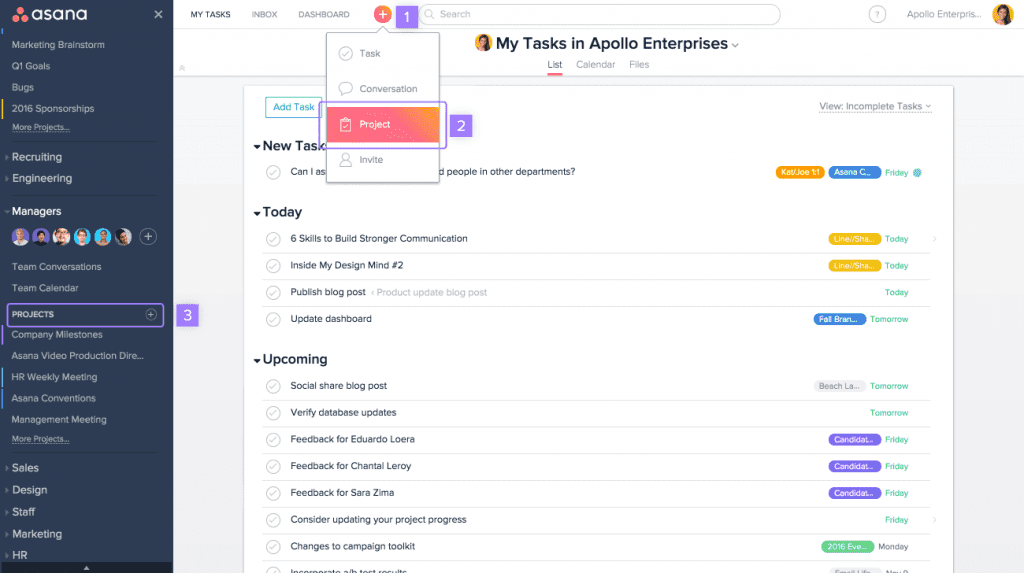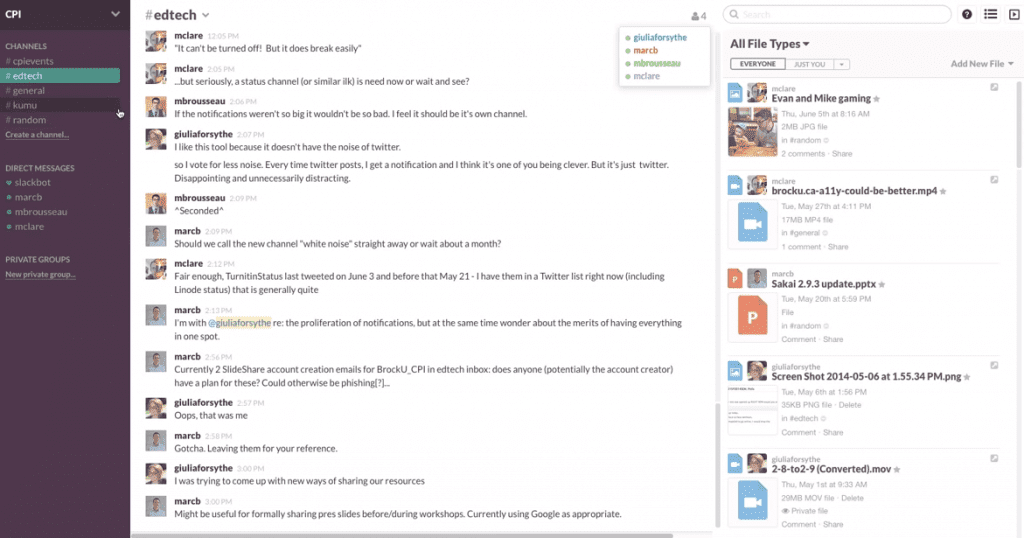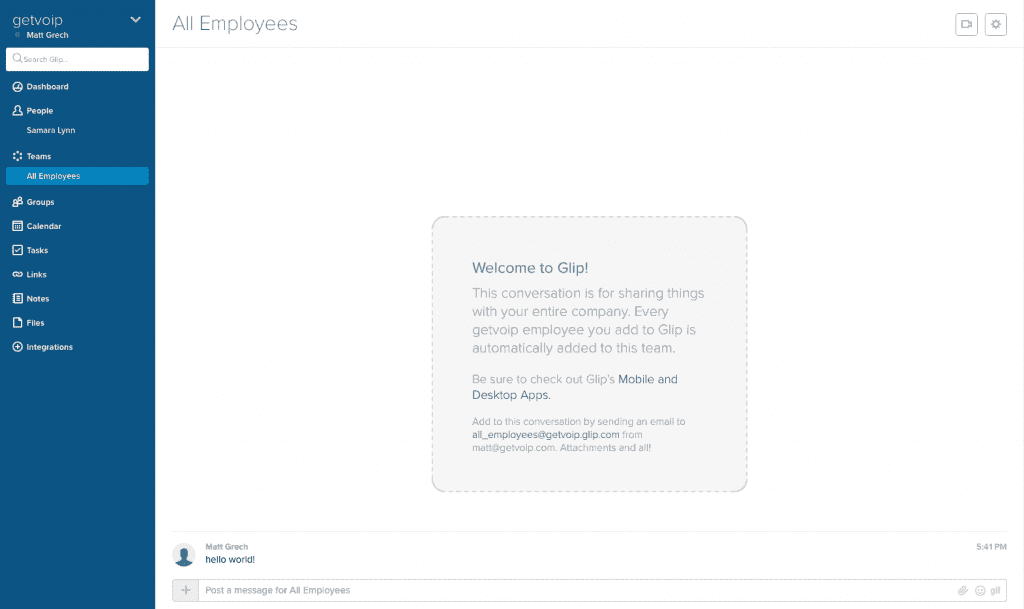|
Provider
|
 RingCentral
RingCentral
#1
|
 Slack
Slack
#2
|
 Asana
Asana
#3
|
 Wrike
Wrike
#4
|
 Microsoft Teams
Microsoft Teams
#5
|
|---|---|---|---|---|---|
| User Reviews | Read Reviews | Read Reviews | Read Reviews | Read Reviews | Read Reviews |
| More Details | |||||
| Provider Overview | |||||
| Headquarters | Belmont, CA | Vancouver, Canada | San Francisco, CA | Mountain View, CA | Redmond, WA |
| Year Founded | 2003 | 2009 | 2008 | 2006 | 1975 |
| Service Location Availability | Wordwide | Worldwide | Worldwide | Worldwide | Worldwide |
| Language Availability | English (US), Chinese (Simple and Traditional), Spanish, French, German, Italian, Russian, Portuguese (BR), Japanese, Korean, Dutch, Danish, Swedish, Finnish, Norwegian, Turkish, Czech, and Polish. | English | English | English, French, German, Italian, Japanese, Portuguese (Brazilian), Russian, Spanish, and Turkish. | English (US), Chinese (Simple and Traditional), Spanish, French, German, Italian, Russian, Portuguese (BR), Japanese, Korean, Dutch, Danish, Swedish, Finnish, Norwegian, Turkish, Czech, and Polish. |
| Types of Services Offered | Team Messaging, Video Conferencing, Chat, Phone | Chat App | Project Management, Team collaboration | Collaboration, Project Management | Project Management, Team Collaboration |
| Most Popular Plan | Office Premium | Standard | Premium | Business | Office 365 Business Essentials |
| Monthly Cost of Popular Plan | 19.99 | $6.67 per active user per month | $8.33 per user per month | $24.80 per user | $5 per user per month |
| Money Back Guarantee | 30 days free trial. Cancel anytime. | No | No | No | No |
| Free Version | Yes | Yes | Yes | Yes | No |
| Free Trial | Yes | No | No, can use Free Version to try out | No | Yes |
| Month to Month Option | Yes | Yes | No | No | Yes |
| Annual Prepay Discount | Yes | Yes | No | No | Yes |
| Mobile App | Yes | Yes | Yes | Yes | Yes |
| Desktop App | Yes | Yes | Yes | Yes | Yes |
| Web Browser Access | Yes | Yes | No | Yes | Yes |
| More Details | |||||
| All Available Features, & Pricing | |||||
| Best Practice Templates | |||||
| Calander Integration | |||||
| Contact Management | |||||
| Customizable Dashboards | |||||
| Dashboards | |||||
| Data Exports | |||||
| Data Imports | |||||
| Document Uploads | |||||
| Email Intergration | |||||
| Feedback in Context | |||||
| File Collaboration | |||||
| File Storage Limit | 2GB free/5GB Professional/50 GB Business/100gb Enterprise | ||||
| File Previews | |||||
| Group Calendars | |||||
| Group Messaging | |||||
| Guest Access | |||||
| Instant Chat/Messaging | |||||
| Organized workspaces | |||||
| Project Management | |||||
| Push Notifications | |||||
| Task Management | |||||
| User and Content Permissions | |||||
| Video Conferencing | Skype Integration | ||||
| More Details | |||||
| Support | |||||
| Hours & Location | 24/7 Worldwide | NA | NA | 24/7 | NA |
| Email Support | |||||
| Instant Chat | |||||
| FAQs Section | |||||
| Video Tutorials | |||||
| E-Guides | |||||
| Online Ticket Submissions | |||||
| More Details | |||||

|
Belmont, CA
|
Read Reviews | |

|
Vancouver, Canada
|
Read Reviews | |

|
San Francisco, CA
|
Read Reviews | |

|
Mountain View, CA
|
Read Reviews | |

|
Redmond, WA
|
Read Reviews |
What is Team Collaboration Software?
Team collaboration software is any type of web-based tool that helps two or more people coordinate, manage, and track their efforts on a given project or task. From conferencing software to calendar sharing, team collaboration tools make it easier to keep a team working tightly together, even when members are working remotely or in different locations.
Team collaboration describes integrated solutions that bring together a suite of such tools in a single product. Most modern solutions involve web-based or app-based portals that have synchronized mobile options to keep people cooperating smoothly while on the go.
Using team collaboration provides a way to streamline communication. The most powerful options include tools to store relevant files, correspondence, tasks, and to-do lists in one place. They provide a one-stop solution for managing and tracking the progress of complex projects.
Key Benefits & Features of Team Collaboration Solutions
Unified Communications
It’s hard for any team to keep track of the emails, IMs, text messages, group chats, and virtual meetings that pile up during a project. It’s easy to forget who mentioned a given solution, when an important message came in, or where that one specific email went.
Robust team collaboration platforms compile everything together in one searchable location, making unified communications easier than ever.
Calendar Integration
Rather than handling a variety of different staffing schedules and conflicts, team collaboration tools can tell you who is available at what time. Rather than manually inputting data, everything can be integrated and automated.
Meetings, tasks, todos or deadlines will be laid out in one place, leaving little room for error, conflict, or excuses.
Activity Streams
Knowing where everyone is on a project is hard when juggling your workload. With activity streams, you know no one is going to drop the ball because you’re able to keep tabs on things.
Remote File Access
Team collaboration means having everyone on the same page, literally and conceptually. The best way to do this is by having remote file access using cloud-based file storage.
Remote file access allows all collaborators to get access to a file wherever they go. When they can open a document any time and anywhere, the project can keep moving.
File Versioning Control
Keeping track of a file as it changes has always been a challenge. In earlier iterations of online collaboration, teams would have to keep checking as to whether or not they had the latest version. With versioning control, that’s no longer an issue.
The robust versioning features included in most team collaboration software are essential. They allow changes made inside of a document to be tracked, creating a digital paper trail of the lifespan of a project.
Conferencing
One basic feature of any team collaboration solution is to be the ability to conference. This allows you to integrate your project communications in real-time if necessary.
Screen Sharing
Seeing what’s happening is sometimes better than trying to explain it. Rather than having to send screenshots or screen captured videos, screen sharing brings everyone to the table and spares from lingering questions.
Whether you’re using it for training, presentations, video interviews, or customer service, jumping into screen sharing is a must for team collaboration software.
What to Look for in a Team Collaboration Solution
Ease of Use
If your collaboration software is too complicated, people won’t use it. It will just add more opportunity for conflict and introduce more noise into the conversation.
Look for an intuitive UI and focus on the features you need. Extraneous features might end up costing you more and crowd your UI.
Integrations
When you have too many different applications to keep your business afloat, you could end up cluttering rather than streamlining your workflow. Make sure that there’s a robust list of integrations available for your team collaboration software.
The ability to holistically integrate the solution with the tools you’re already using is a big plus for your team and will result in a substantial boost in productivity.
Integrated and Targeted Messaging
While the ability to store all project conversations centrally is one of the most important parts of a team collaboration tool, it’s even more useful if comments are connected to the project they’re related to. It’s also helpful to have the ability to directly tag contributors, with an @mention, for example, which will notify them for a quick response.
Mobile
One of the main benefits of team collaboration solution is its ability to connect an increasingly mobile workforce. Your software should provide smooth usability with mobile devices.
Cloud-based web applications require natively-written mobile apps. Mobile-optimization with constant synchronization is the indicator of a strong tool.
Use Cases For Team Collaboration Solutions
While the concept of team collaboration software might be attractive, some business owners might not understand the power of these solutions. Here are a few use cases to help illuminate why these tools matter.
Use Case #1: Managing Team Tasks

These software solutions come into play when a department supervisor has a series of tasks to divide between different team members. They need the ability to track the progress of the project as they finish each task.
They need the ability to set the tasks up individually and to track their status. Each team member needs a dashboard showing either just their tasks or the entire project team depending on what the team leader demands. Here, the supervisor can watch the progress of each task as employees check off each task.
Then, for supreme productivity, the people following that task can be notified that a change has been made.
Asana helps companies to facilitate communication among teams in just about any industry. The software allows for real-time collaboration and integrates with cloud-based file-sharing apps like Dropbox and Google Drive. Tasks can be assigned to multiple people and tracked with ease using the task management assignment feature.
Use Case #2: Tracking A Project from Start to Finish
![]()
Project managers must keep up with the latest progress of several micro tasks connected to a larger project. Each team needs to be able to add documentation and provide updates on the portion of the project they have responsibility for.
With this software, the project manager can assign each task to a team member. Subtasks can be created with a timeline to track start and completion times. Teams can add documentation as needed and leave it available to everyone related to the project.
Inside of this software, there’s the opportunity to chat and send messages. This clarifies issues and helps contribute to a timeline updating the project manager on progress. They can then report the status of the project out to upper-level management at any point.
Wrike is a collaboration tool optimized for end-to-end tracking of waterfall and agile projects. It covers projects from conception to delivery. Teams and project managers can communicate updates and reports to every interested stakeholder. This leaves everyone with a 360-degree view of what’s happening during each phase.
Use Case #3: Messaging with Team Members

Team collaboration applications can help an associate tasked with putting together an event for their department. Some of the team works remotely and only come into the office occasionally.
Collaboration software gets the whole department together in a virtual chatroom, allowing attendees to add attachments and share their screens. The associate can export a log of the chat that happens within the main area. Members can also privately message one another if they need to have a sidebar about any issues.
Slack allows users to contact other team members in real-time. Users can share screens and preserve sessions for future reference.
Use Case #4: Collaboration

If a team receives a last-minute change to a project they’re working on, they need to act quickly. Their brainstorming session can be hindered if one team member is out of the office and only has access to their phone.
Team collaboration software can save the day by giving the missing team member access to the workspace from their mobile device. They can share screens to go through possible scenarios together. Every member can share documents, even the remote one, making sure that everyone’s in the loop.
Glip flows just as well on your phone as it does on a laptop. It’s a collaboration solution that allows you to share ideas and team up with anyone at any time.
Market Trends to Understand
Mobile is Essential
Bring Your Own Device office culture and virtual workspaces are becoming the norm, even at historic enterprises. Market leaders already offer mobile versions of their web-based applications, giving users a leg up.
As the mobile workforce grows ever larger, we’ll see a shift toward collaboration tools offering their mobile apps as the flagship products.
Public and Private Blended
As everything moves to the cloud, collaboration tools aren’t just for internal use. This software is invaluable conduits for client input and cooperation. Letting customers in on the project is helpful in many ways.
So long as their insulated from debate and chatter throughout the process, team collaboration offers them a useful insider’s view. External collaborators and contractors might also appreciate the chance to get a view of the under the hood.
While some companies deal with this by using separate solutions for internal and external use, team collaboration tools offer solutions to integrate the two views in one place. Hierarchies of access allow you to have a public face and private workspace with a single tool.
Executive Adoption
Team collaboration software was the province of the feet on the ground, but as the products mature, corporations continue to flatten. C-level executives are becoming more engaged with the day-to-day, giving them a need for software access.
The ability to manage global teams and customer bases virtually will provide a strong incentive towards adoption at the highest levels of a corporation.
What Makes Team Collaboration Software Vital to Business?
Good team collaboration software can give you an edge throughout the entire lifecycle of a project. These software solutions offer small businesses and enterprises better control over planning, strategy, implementation, and follow-up. They solve common problems that plague any project including miscommunication, scattered messaging trails, and file versioning.
Before making your final choice, see what options matter most to your employees. Without commitment from the actual team, even the best collaboration software will fail. Ask your team about the features they’d like to see, what features seem extraneous, and if there are any potential roadblocks to adoption.
Team collaboration is all about communication, so make sure you’ve prioritized that in your decisionmaking.
Team Collaboration - Additional Resources
- Top 10 Slack Alternatives & Competitors for 2022 (Free & Paid)
- CRM Software
- Slack vs. Microsoft Teams: Team Collaboration and Communication Showdown
- 10 Essential Team Collaboration Features and Which Tools Have Them All
- Stay Organized, Stay Productive – How To Find The Best Team Collaboration Solution
- The 10 Best Free Online Collaboration Tools for 2021
- Unified Communications